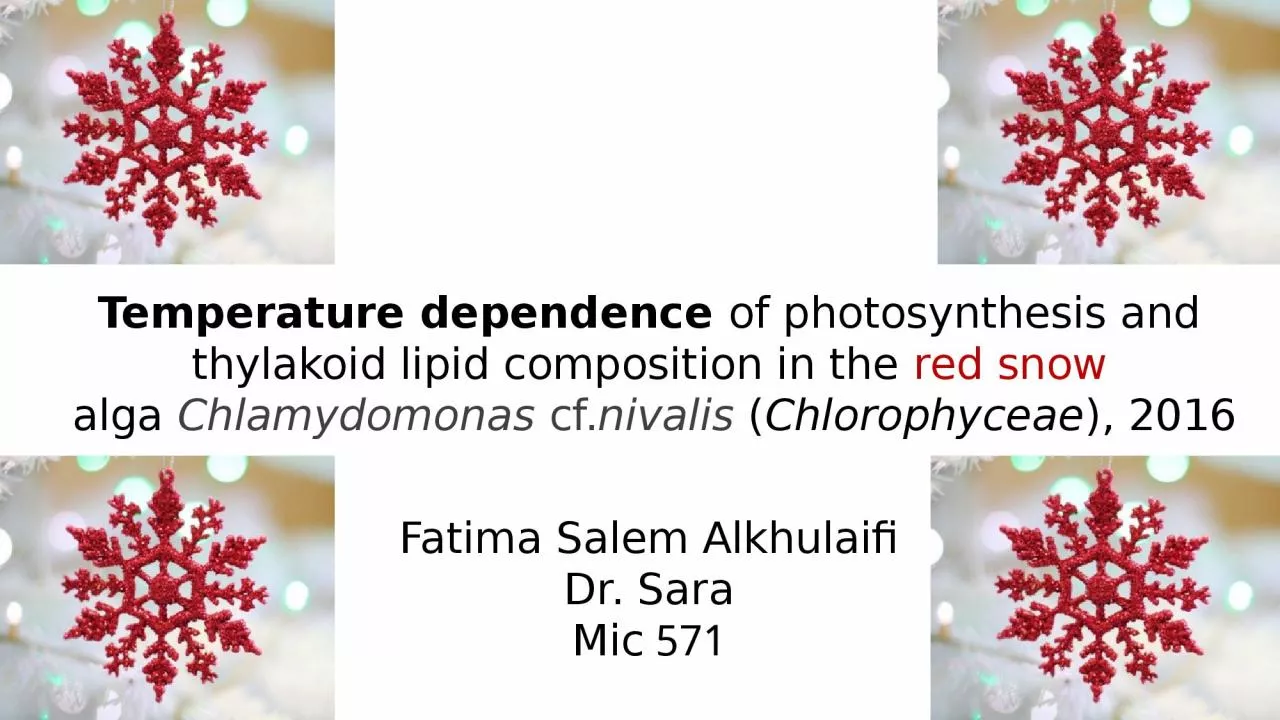

red snow alga Chlamydomonas cf nivalis Chlorophyceae 2016 Fatima Salem Alkhulaifi Dr Sara 571 Mic Here we report an effect of short acclimation to a wide span of temperatures on photosynthetic electron transfer lipid and fatty acid composition in the snow alga ID: 1041762
Download Presentation The PPT/PDF document "Temperature dependence of photosynthesi..." is the property of its rightful owner. Permission is granted to download and print the materials on this web site for personal, non-commercial use only, and to display it on your personal computer provided you do not modify the materials and that you retain all copyright notices contained in the materials. By downloading content from our website, you accept the terms of this agreement.
1. Temperature dependence of photosynthesis and thylakoid lipid composition in the red snow alga Chlamydomonas cf.nivalis (Chlorophyceae), 2016 Fatima Salem AlkhulaifiDr. Sara571 Mic
2. Here, we report an effect of short acclimation to a wide span of temperatures on photosynthetic electron transfer, lipid and fatty acid composition in the snow alga Chlamydomonas cf. nivalis. The growth and oxygen evolution capacity were low at 2 °C yet progressively enhanced at 10 °C and were significantly higher at temperatures from 5 to 15 °C in comparison with the mesophilic control Chlamydomonas reinhardtii. In search of the molecular mechanisms responsible for the adaptation of photosynthesis to low temperatures, we have found unprecedented high rates of QA to QB electron transfer. The thermodynamics of the process revealed the existence of an increased structural flexibility that we explain with the amino acid changes in the D1 protein combined with the physico-chemical characteristics of the thylakoid membrane composed of > 80% negatively charged phosphatidylglycerol.Abstract
3. Watermelon snow, also called snow algae, pink snow, red snow, or blood snow, is Chlamydomonas nivalis, a species of green algae containing a secondary red carotenoid pigment (astaxanthin) in addition to chlorophyll. Unlike most species of fresh-water algae, it is cryophilic (cold-loving) and thrives in freezing water. Its specific epithet, nivalis, is from Latin and refers to snow.Chlamydomonas nivalis
4. This type of snow is common during the summer in alpine and coastal polar regions worldwide, such as the Sierra Nevada of California.Chlamydomonas nivalis
5. Red Snow- A phenomenon happens every year. Spores of Snow Algae cause the snow to turn a dark red.- Snow Algae are single-celled organisms that live in the snow under extreme conditions. In the spring, they have a vibrant green color. They awaken and proliferate…first causing the snow to become green.- In the winter, the Snow Algae turn to red colour because the nutrient level is restricted, and start to produce carotenoids and other metabolites.
6.
7.
8.
9.
10. The Importance of ResearchAntioxidantAntiagingThe Next Fountain of YouthActivate Longevity genes KL (Klotho).Cellular energy enzyme AMPK(adenosine monophosphate-activated protein kinase).Both of these mechanisms help faciliate DNA repair
11. The carotenoids and metabolites turn the Red Snow Algae into a veritable “Revive Aging Skin” for the skin. At this point, the algae is:1- Extracted.2- Dried 3- Turned into Red Snow Algae powder.Drink this powder with water as a supplement Use it in anti-aging skin care productsThe plant stem cells derived from powderThe Problem of ResearchThe best time and condition of temperature to extract snow algae
12. Oxygen evolutionElectron transfer rate measurementsFluorescence temperature curveMaterials & Methods1234Isolation of thylakoid membranes5Extraction of lipids6Lipid and fatty acid analysis7DNA isolation8Amplification of gene coding D1 protein9Alignment of gene coding D1 protein10Statistical analysis11C. cf. nivalisC. reinhardtiiBBM mediumContain 16 chemical compounds2 C10 C5 – 15 C(72 hr using thermostat)Organisms and growth conditions
13. Results & DiscussionSnow-forming C.cf. nivalis cannot be regarded as cryophilic but rather a cryotolerant species with very good photosynthetic performance at low temperatures.It is important to note that our strain of C. nivalis acclimated to 2.5 °C exhibits significantly faster growth (at 5–15 °C) and oxygen evolution rate (at 5–20 °C) in comparison with the mesophilic control.What molecular mechanisms are employed to yield the snow alga this rather broad thermal tolerance?
14. Oxygen evolution rates of the snow alga surpass the mesophilic control within the range of 5 to c.20 °C even when the two strains were pregrown at identical temperature of 24 °C. The important role of lipids as mediators of thermal acclimation of membrane proteinsMoreover, our analysis of control samples taken from cells grown for 3, 5 and 10 days showed that all the changes in the fatty acid content occurred within a time span shorter than 3 days. This fact documents cells’ potential to quickly acclimate their fatty acid composition regardless of the temperature outside its growth optimumResults & Discussion
15. The growth and oxygen evolution capacity were low at 2 °C yet progressively enhanced at 10 °C and were significantly higher at temperatures from 5 to 15 °C in comparison with the mesophilic control Chlamydomonas reinhardtii. In search of the molecular mechanisms responsible for the adaptation of photosynthesis to low temperatures, we have found unprecedented high rates of QA to QB electron transfer. The thermodynamics of the process revealed the existence of an increased structural flexibility that we explain with the amino acid changes in the D1 protein combined with the physico-chemical characteristics of the thylakoid membrane composed of > 80% negatively charged phosphatidylglycerol.Summary
16. The EndThanks for pay Intention